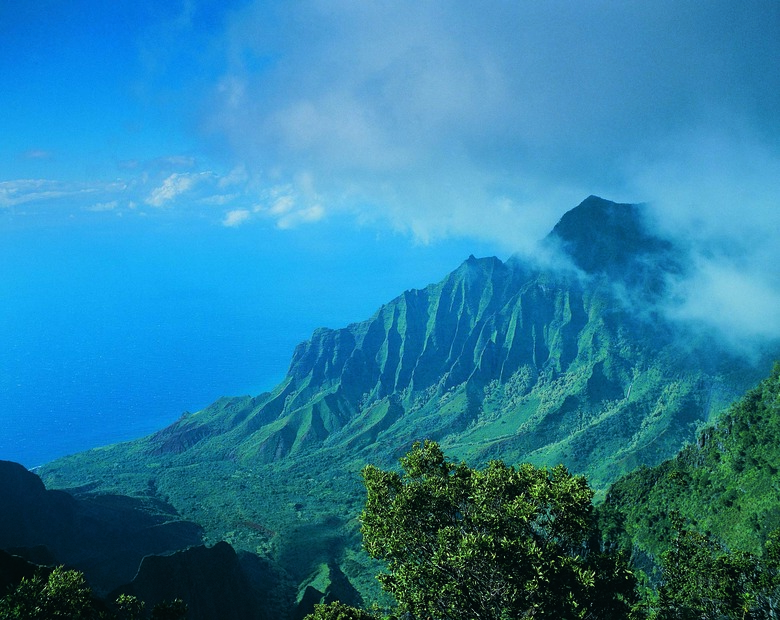What Major Wind Belts Affect Our Climate The Most?
The planet's wind currents can be fitful and unpredictable, particularly on the small scale: a sudden gust sweeping down a mountainside, a tornado loosed from a thunderhead, a tiny eddy of breeze caused by a pebble on a mudflat.
Global wind patterns, however, are somewhat more orderly, even in their seasonal variations. At high altitudes they generally blow easterly over the tropics and the poles and westerly elsewhere. Several major wind belts exert a major influence on climate.
Large-Scale Types of Winds
Large-Scale Types of Winds
Wind, which is basically moving horizontal air, stems from variations in air pressure primarily due to differential heating of the planet by the sun. While it's theoretically true that wind flows from an area of high pressure to an area of low pressure, modifying factors ensure a more complicated situation in practice.
The Coriolis effect — the impact of the Earth's spin — deflects wind currents to the right in the Northern Hemisphere and to the left in the Southern Hemisphere. Friction, meanwhile, creates a drag on surface-level types of winds.
The great planetary wind belts are associated with broad patterns of global atmospheric circulation essentially put in motion by the heat surplus of the tropics and the heat deficit of the poles.
The Trades
The Trades
By geographic extent and consistency, the trade winds are perhaps Earth's foremost. These westerly breezes blow toward the equator from the subtropical highs, coalescing in the cloudy equatorial belt called the Intertropical Convergence Zone. As their name suggests, the trade winds have played an enormous role in human history by facilitating transoceanic commerce and exploration.
They evaporate large amounts of moisture off the ocean surface; when shoved upward by rugged topography — as on volcanic islands — they may unleash massive amounts of rainfall. The trades are also notable as primary conduits for tropical cyclones. In a few corners of the globe, most notably southern Asia, normal trade-wind flow is modified by monsoons.
The Westerlies
The Westerlies
Air rising at the equator and migrating poleward is swung by the Coriolis effect and funneled by the conservation of angular momentum into the westerlies, the great weather-shaping winds of the midlatitudes.
Because of the spheroid shape of the planet, the higher-latitude westerlies don't dominate such a large area as the trades. And because much of their territory is over land — with its topographic convolutions and wild temperature variations — they are less consistent near Earth's surface.
At high altitudes, two jet streams — fast-moving wind funnels — form the heart of the westerlies: the polar and subtropical jets. The polar jet, roughly marking the frontier between cold air poleward and warmer air equator-ward, is usually more significant in terms of surface weather.
Oscillations in the westerlies called Rosby waves can pull frigid polar air well into the temperate zone. As hurricanes and typhoons slough along the trades, the westerlies often convey stormy extratropical cyclones across the midlatitudes.
The Polar Easterlies
The Polar Easterlies
Usually cold and parched, the polar easterlies reign in the latitudes between 60 degrees and the high-pressure cells that sit upon both poles. The polar easterlies of the Northern Hemisphere in particular show significant seasonal variation, weakening substantially in the short Arctic summer.
The boundary between the polar easterlies and the midlatitude westerlies — the polar front — is marked by the subpolar lows, which stretch from about 50 to 60 degrees of latitude. These volatile frontiers are major storm factories.
Cite This Article
MLA
Shaw, Ethan. "What Major Wind Belts Affect Our Climate The Most?" sciencing.com, https://www.sciencing.com/major-wind-belts-affect-climate-most-23368/. 7 May 2019.
APA
Shaw, Ethan. (2019, May 7). What Major Wind Belts Affect Our Climate The Most?. sciencing.com. Retrieved from https://www.sciencing.com/major-wind-belts-affect-climate-most-23368/
Chicago
Shaw, Ethan. What Major Wind Belts Affect Our Climate The Most? last modified March 24, 2022. https://www.sciencing.com/major-wind-belts-affect-climate-most-23368/
